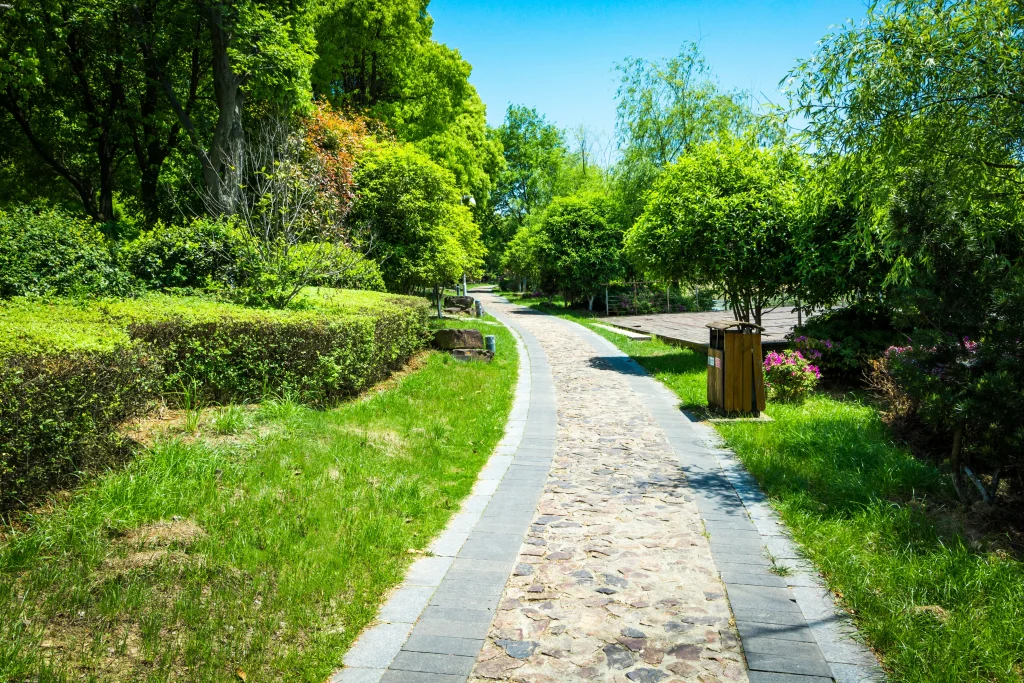Few things frustrate gardeners more than seeing freshly spread mulch wash away. Between Denver’s Chinook winds, downpours, and sloped yards, keeping mulch in place can feel impossible.
But with the right combination of anchoring techniques, smart materials, and slope design, you can keep mulch from washing away – protecting your soil, plants, and curb appeal all season long.
In this guide, you’ll learn:
- Why mulch washout happens
- How to prevent mulch from washing away using 10 proven methods
- The best mulch types for erosion-prone yards
- Local solutions for slopes, drainage, and heavy rain
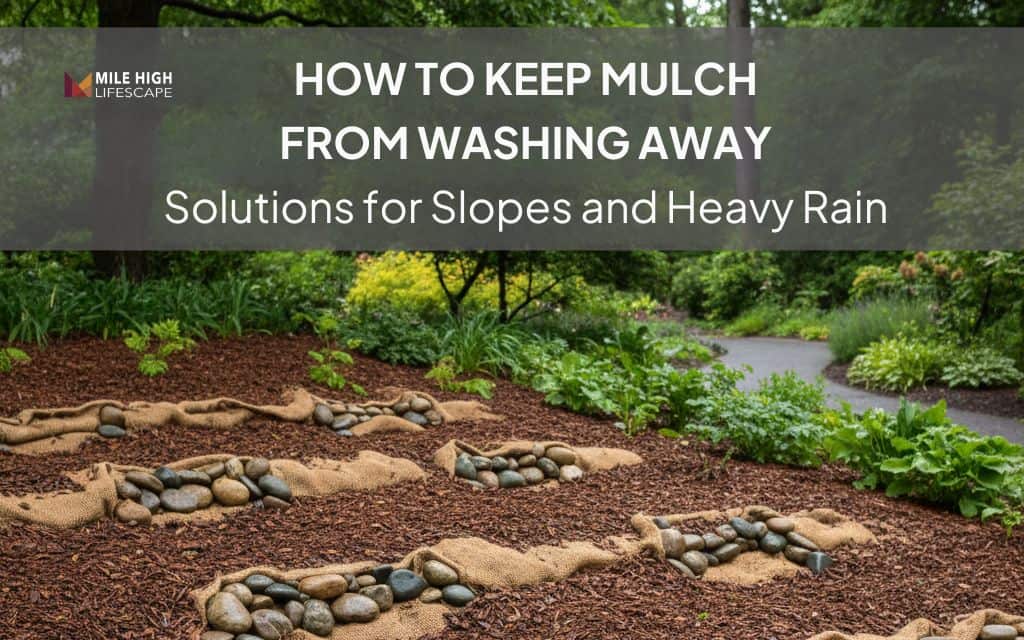
Why mulch washes away
Understanding why your mulch keeps disappearing is the first step to stopping it permanently.
Heavy spring storms and sudden downpours
Front Range weather can dump inches of rain in an hour, enough to float and sweep away lightweight mulch. These intense spring storms arrive with little warning, turning your carefully mulched beds into muddy messes.
The combination of rainfall and Denver’s clay-heavy soil (which doesn’t absorb water quickly) creates surface runoff that carries mulch straight into your driveway or street.
Melting snow and ice runoff
In late winter and early spring, snowmelt combined with sloped yards often creates mini streams that carry mulch downhill. This is particularly problematic in Denver’s foothill neighborhoods like Green Mountain, Littleton, and Castle Rock, where properties naturally slope.
Winds and high altitude exposure
Denver’s low humidity dries mulch quickly after storms. Lightweight bark becomes almost weightless in dry conditions. Wind gusts during Chinook events reach 40 miles per hour or more. These sustained winds blow dried mulch across yards and into neighboring properties. The problem intensifies on exposed slopes and windy ridgelines throughout the Metro area.
Poor bed design or lack of barriers
Steep slopes, unedged beds, and downspout overflow accelerate erosion. Many Denver homes were built on hillsides without adequate landscape engineering.
If your flower beds lack physical barriers, water follows the path of least resistance and straight through your mulch. Downspouts that empty directly onto mulched areas create concentrated water flow that’s nearly impossible to stop without proper drainage solutions.
Choose the right mulch to stay put
Mulch selection makes the difference between annual replacement and stable coverage. Different materials resist washout through weight, interlocking structure, or both.
| Mulch Type | Durability | Washout Resistance | Best Use |
| Shredded hardwood mulch | High | Excellent | Sloped or high-wind areas |
| Rubber mulch | Very high | Excellent | Driveway edges, playgrounds |
| Compost or leaf mulch | Low | Poor | Flat vegetable beds only |
| Stone or gravel mulch | Very high | Outstanding | Xeriscapes, permanent beds |
| Pine bark nuggets | Medium | Poor | Avoid on slopes |
| Cedar mulch | Medium | Fair | Light slopes, flower beds |
- Shredded hardwood mulch interlocks when settled. The stringy texture creates a mat that resists both wind and water movement. This material works well on moderate to steep slopes. The dark color also absorbs heat, helping soil warm faster in spring.
- Rubber mulch never floats or decomposes. The weight and texture prevent washout completely. However, the material costs more and doesn’t improve soil over time.
- Stone and gravel provide the ultimate washout resistance. River rock, pea gravel, and decorative stone stay in place during the worst storms. These materials suit xeric landscapes and areas where organic mulch repeatedly fails.
- Pine bark nuggets and cedar chips work for protected beds with minimal slope. Their rounded shape and light weight make them prone to floating. Save these materials for flat flower beds away from drainage paths.
Tools and materials you’ll need
Before you tackle keeping mulch in place, gather these essential materials. Most are available at local Denver-area suppliers:
| Tool/Material | Purpose |
| Landscape edging (metal or stone) | Holds mulch in place |
| Mulch Lock Spray | Bonds mulch to soil |
| Jute netting or landscape fabric | Erosion control |
| River rock or pea gravel | Anchoring border |
| Hand rake | Re-leveling mulch |
| Mulch tamper or roller | Compresses top layer |
| Landscape staples | Secures fabric/netting |
| Shovel and wheelbarrow | Installation |
Having these tools ready before starting your project saves trips to the store and ensures you can stop mulch from washing away properly the first time.
How to keep mulch from washing away: 10 proven methods
These techniques prevent mulch washout through different mechanisms. Combine multiple methods for complete protection against Denver’s challenging conditions.
Install landscape edging or borders
Physical barriers contain mulch within defined bed boundaries. Metal edging bends to create curves and withstands freeze-thaw cycles. Stone borders add visual weight while preventing mulch migration. Concrete curbing provides permanent containment for high-traffic edges.
Install edging at least 2 inches above the final mulch surface. This height stops water from carrying mulch over the barrier during heavy runoff.
Secure metal edging with stakes every 3 feet. Stack stone borders 2 layers deep for added stability. The barrier prevents mulch from washing onto driveways, patios, and sidewalks where it creates slip hazards and maintenance problems.

Use mulch lock spray or landscape adhesive
Biodegradable bonding sprays lightly glue mulch pieces together. The adhesive forms a flexible mat that resists wind and water displacement. Apply the spray to freshly installed mulch or before forecasted storms.
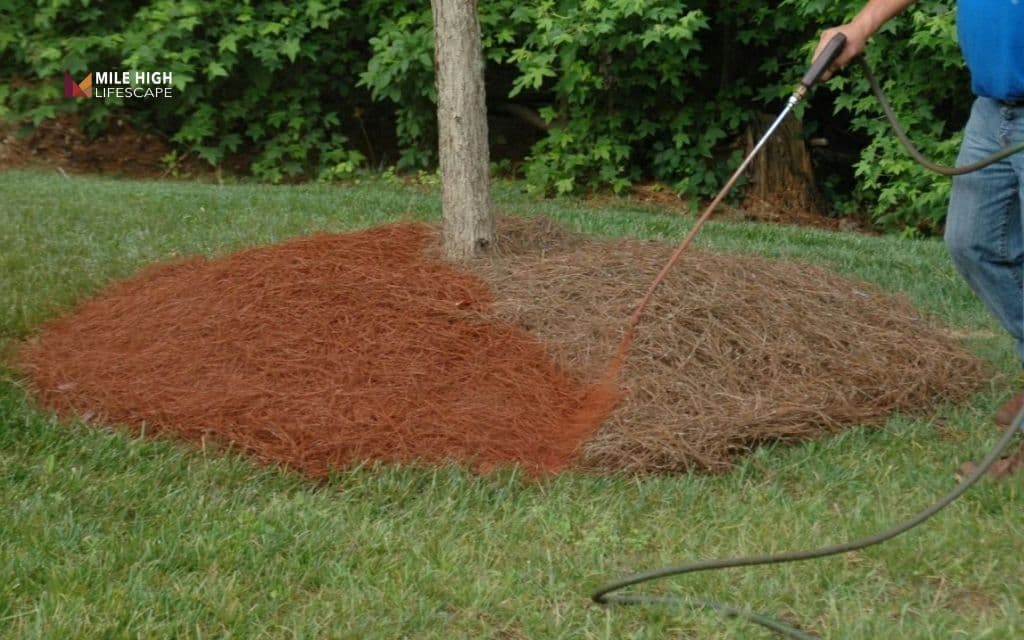
Mix in heavier material (stone, gravel, or compost)
Combining materials creates natural anchoring. Mix three-quarter-inch gravel with organic mulch at a ratio of one part stone to three parts mulch. The stone settles to the bottom, creating a stable base layer. The organic material on top provides the appearance and soil benefits you want.
This hybrid approach works well for beds that need both drainage and organic matter. The gravel prevents floating while allowing water to percolate. Compost adds weight when mixed into lightweight bark mulch.
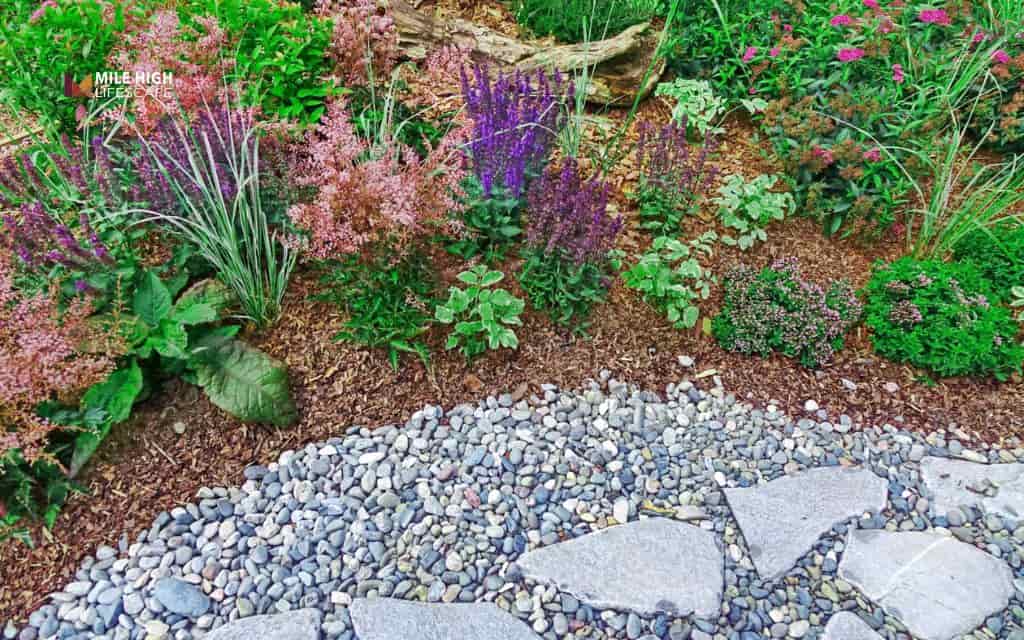
Create terraces or retaining edges on slopes
Steep beds require structural intervention to slow water flow. Build mini terraces across the slope using landscape timber, stacked stone, or pavers. Space these baffles 4 to 6 feet apart vertically, depending on the slope angle.
Each terrace creates a flat section that traps mulch and soil. Water flows over the barriers instead of through the mulch layer. The terraced design also creates planting pockets for deeper-rooted shrubs and perennials. These plants further stabilize the slope while adding visual interest.
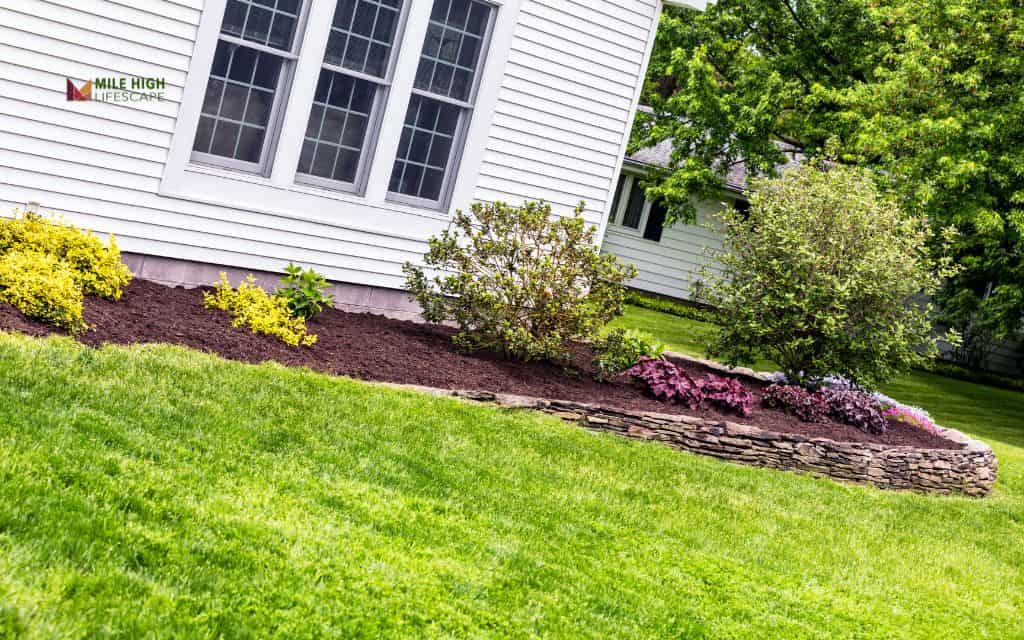
Lay down landscape fabric or jute netting under mulch
Ground covers provide friction that locks mulch in place. Landscape fabric blocks weeds and creates a grippy surface. Jute netting offers biodegradable erosion control that works for natural landscapes.
Unroll fabric or netting across the bed before adding mulch. Overlap edges by 6 inches to prevent gaps. Secure the material with landscape staples every 12 inches, more frequently on steep slopes. The fabric prevents mulch from mixing with soil and creates a barrier against weed seeds.
Jute netting excels on slopes where erosion threatens both mulch and soil. The open weave allows water and nutrients to penetrate while holding materials in place. Plant roots grow through the mesh, eventually replacing the netting’s stabilizing function as it decomposes.

Redirect downspouts and runoff flow
Concentrated water flow from downspouts causes the worst washout damage. Install splash blocks or downspout extensions to move water away from mulched beds. Direct the flow to gravel-filled dry creek beds or rain gardens. These features handle concentrated runoff without disturbing nearby mulch.
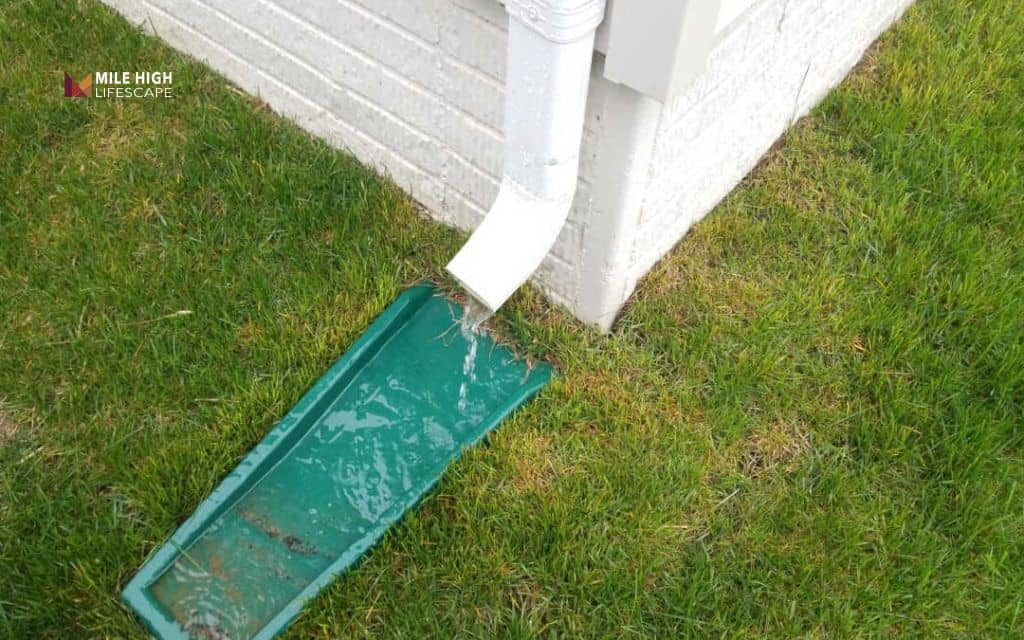
Water your mulch after spreading it
Light moisture helps fresh mulch settle and bond. Mist the surface lightly using a gentle spray nozzle. The water adds temporary weight and helps mulch pieces nestle together.
This technique works best immediately after installation. The moisture activates natural bonding between wood fibers. Denver’s dry air normally prevents this initial settling. A light watering compensates for the low humidity.
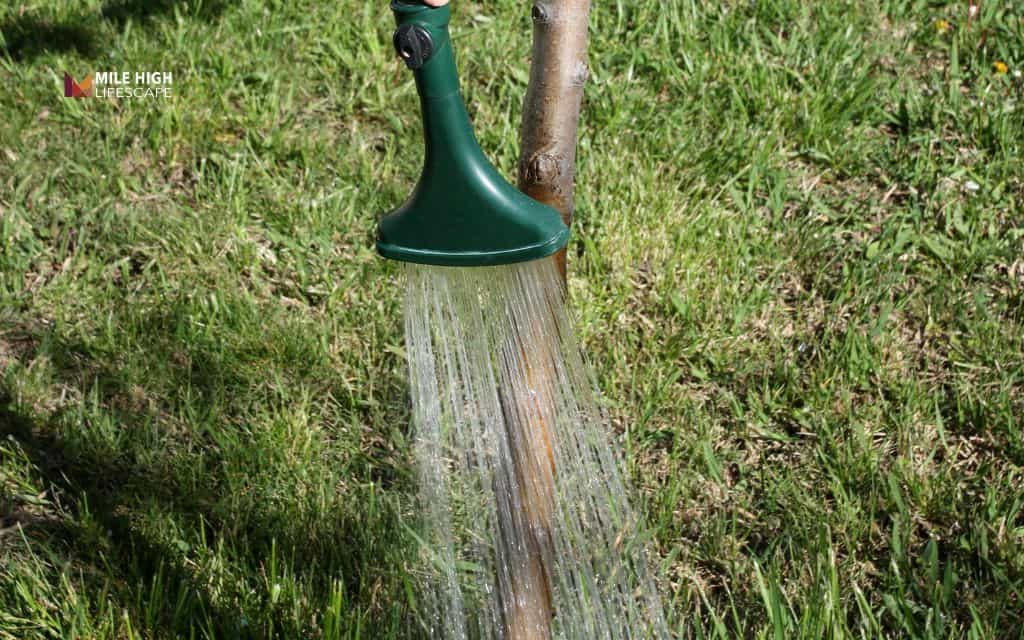
Install a perimeter plant barrier
Low-growing groundcovers and ornamental grasses create living barriers. Plant these around mulched bed edges to slow runoff and reduce wind impact. Roots anchor soil while the foliage catches and slows water flow.
Creeping phlox, sedum, and ajuga work well in Denver’s climate. These plants tolerate the edge conditions where mulch meets lawn or pavement. Ornamental grasses like blue fescue or Mexican feather grass add height and visual interest while breaking up wind flow across mulch surfaces.
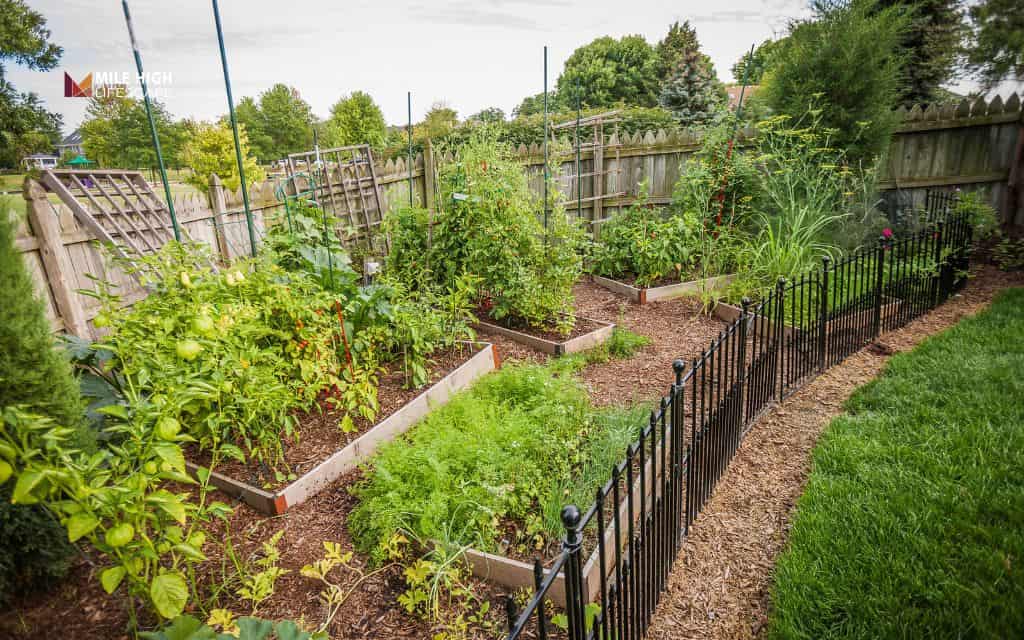
Add small rock borders or decorative berms
Install a 3- to 4-inch-wide strip of small stone between mulch and hard surfaces. The rock prevents mulch from migrating onto walkways.
River rock berms along the downhill edge of sloped beds catch mulch that starts to move. These barriers allow water to flow through, trapping displaced organic material. The rock provides attractive accents that complement both mulch and plantings.
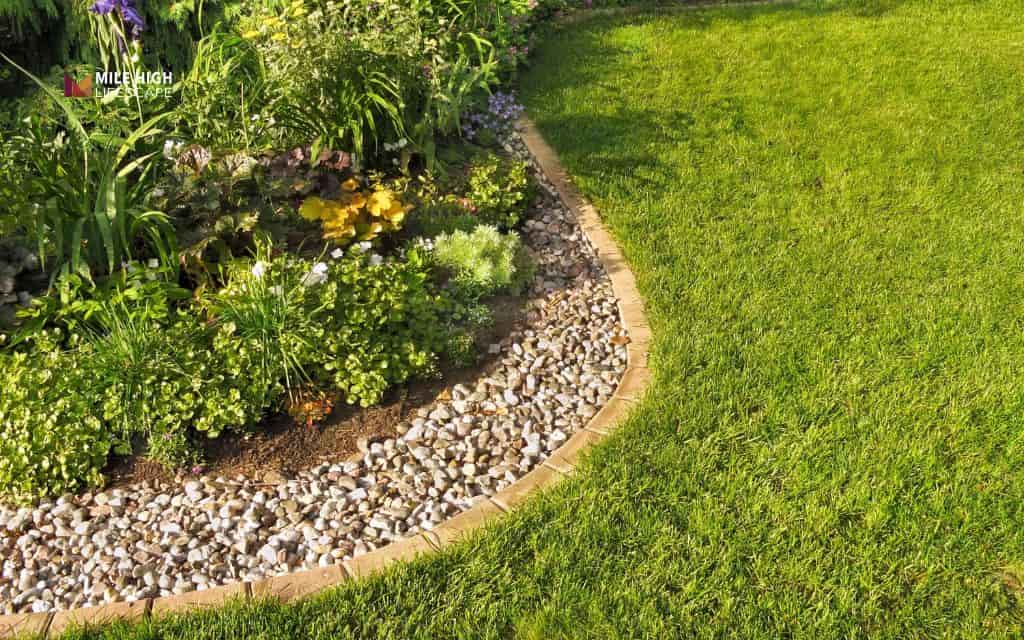
Use erosion control mats for extreme slopes
Severe embankments require commercial erosion control products. Coir fiber mats and geo-grid fabric secure both soil and mulch on slopes that exceed 30 degrees. These products provide structure that natural settling cannot achieve.
Roll out the matting across the slope, securing it at the top with landscape staples or buried edges. Overlap sections by 6 inches. Spread mulch over the matting to the desired depth. The mat holds everything in place while allowing water to flow through to the soil below.
Coir mats last 3 to 5 years before decomposing completely. During that time, planted vegetation establishes root systems that replace the mat’s stabilizing function. This method works for challenging slopes where other techniques prove insufficient.

Special tips for Denver’s conditions
Denver’s climate and geography create specific mulching challenges. These targeted strategies address local conditions that don’t apply to gardeners in other regions.
Account for snowmelt patterns
Avoid loose organic mulch in areas where plowed snow accumulates. The spring melt creates sustained runoff that will carry bark and wood chips away. Use stone mulch in these zones or install drainage systems to move water around vulnerable beds. Snow piles can last into April in shaded areas, creating weeks of water flow as they slowly release.
Handle high wind exposure
Keep mulch surface 1 to 2 inches below the curb or edging level. This creates a basin effect that reduces wind impact on the mulch surface. Wind skims over the top of recessed mulch rather than catching individual pieces. This simple adjustment reduces blowout significantly in exposed Denver locations.
Watch drainage patterns after storms
Observe how water moves through your landscape during the next heavy rain. Note where channels form and where water puddles. These observations reveal where to reinforce barriers, add drainage features, or switch to heavier mulch materials. Denver’s intense but brief storms often expose drainage problems that aren’t obvious during dry periods.
Use native plants for natural stabilization
Native Colorado plants develop extensive root systems that anchor soil and mulch. Blue grama grass, Rocky Mountain penstemon, and blanket flower thrive in Denver conditions while providing natural erosion control. These plants require less water than traditional landscaping, addressing water conservation needs while solving mulch retention problems.
Schedule strategic maintenance
Inspect mulched beds after major storms and during spring thaw. Rake displaced mulch back into place while it’s still nearby. Tamp down loose sections that show signs of movement. These quick interventions prevent small problems from becoming complete washouts. Schedule annual mulch refreshment in late April or early May, after the worst of spring runoff but before summer heat intensifies.
Conclusion
Keeping mulch in place isn’t just about looks, it’s about preserving soil health, preventing erosion, and saving money on replacement materials year after year.
With the right combination of:
- Heavy, interlocking mulch materials (shredded hardwood or stone)
- Proper edging and slope management (borders, terracing, barriers)
- Strategic water flow control (downspout redirection, drainage planning)
…you can stop mulch from washing away permanently.
The key is understanding that preventing mulch from washing away requires a multi-layered approach. No single method works perfectly in all situations, but combining 2-3 techniques tailored to your specific yard conditions creates virtually washout-proof beds.
_____________
Tired of watching your mulch wash away every season?
Mile High Lifescape specializes in erosion-proof landscape design and mulch installation throughout the Denver metro area. Our team understands Denver’s unique challenges and knows exactly how to keep your mulch in place year-round.
We offer comprehensive solutions including:
- Professional mulch installation with proper anchoring techniques
- Slope stabilization and terracing design
- Drainage solutions and downspout management
- Erosion control systems for challenging properties
- Custom landscape edging and border installation
Contact us at (303) 877-9091 or hello@milehighlifescape.com for a free consultation today!
Frequently asked questions (FAQ)
How do you keep mulch in place on a slope?
The most effective approach combines 3 strategies: use shredded hardwood mulch, secure with landscape fabric or jute netting underneath, and add terraced sections or physical baffles every 3-4 feet to slow water flow. For slopes steeper than 25 degrees, install erosion control mats before mulching.
Does mulch lock spray really work?
Yes, especially for lightweight bark mulch. Mulch lock spray forms a biodegradable adhesive layer that bonds mulch pieces together. Results typically last 6-12 months before reapplication is needed. It’s most effective when applied to dry mulch on calm days, allowing 24 hours to cure before rain exposure.
How often should I reapply mulch in Denver?
Most landscapes need fresh mulch once per year, typically in spring (April-May) before summer heat and monsoon rains arrive. However, inspect after snowmelt and major storms for displaced areas that need spot treatment. Well-anchored mulch using proper prevention methods can last 2-3 years before significant breakdown occurs.
Can I mix stone and mulch together?
Absolutely, a hybrid design adds beauty and weight, making your mulch nearly wash-proof. Mix pea gravel or small river rock with shredded hardwood mulch. The stone settles between organic material, anchoring everything in place while still allowing decomposition to enrich soil.
Is rubber mulch good for preventing washout?
Yes, rubber mulch offers the highest washout resistance of any material due to its weight and interlocking texture. It’s virtually blow-proof and won’t float away in heavy rain. However, it doesn’t improve soil health like organic mulch and has environmental concerns.
What can I use to keep mulch in place without chemicals?
Several natural solutions work: jute netting, landscape fabric, rock borders, and plant barriers. These methods keep mulch from washing away without synthetic adhesives or chemicals, making them ideal for organic gardens and environmentally conscious homeowners.
Is rubber mulch good for preventing washout?
Yes, rubber mulch offers the highest washout resistance of any material due to its weight and interlocking texture. It’s virtually blow-proof and won’t float away in heavy rain. However, it doesn’t improve soil health like organic mulch and has environmental concerns.
How do I keep mulch off sidewalk areas during storms?
Install physical edging at least 2 inches high along sidewalk borders, or create a rock border “moat” using pea gravel between the mulch bed and pavement. Ensure mulch level stays 1-2 inches below the top of edging to prevent overflow during heavy rain. For driveways and sidewalks with severe runoff issues, switch to stone mulch within 12 inches of paved surfaces.
